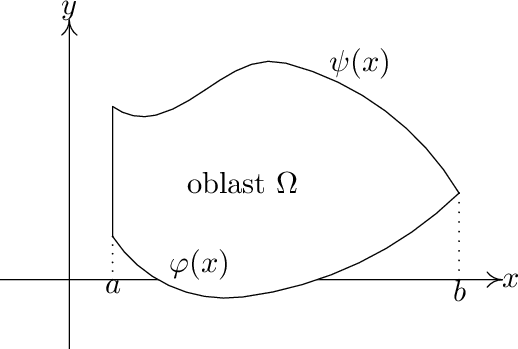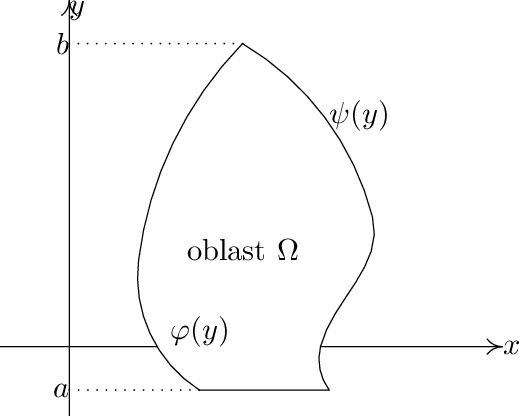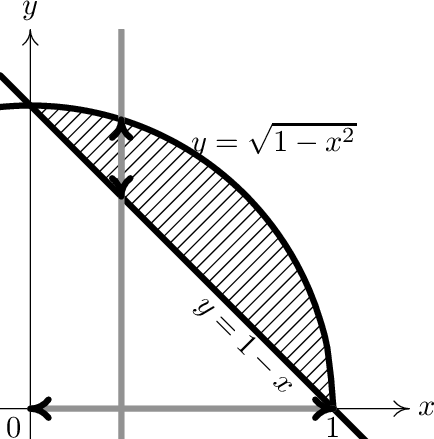3 Dvojný integrál v obecné oblasti
Definice 3.1 (dvojný integrál v obecné oblasti). Buď \( \displaystyle \Omega \) uzavřená ohraničená oblast. Buď \( \displaystyle R\) dostatečně velký obdélník, takový, že \( \displaystyle \Omega \subseteq R\). Definujme na \( \displaystyle R\) funkci \( \displaystyle g\) předpisem
| \[ g(x,y) = \left \{\array{ f(x,y)\quad & (x,y)\in \Omega \cr 0 \quad & \text{jinak}} \right . \] |
Potom definujeme integrál funkce \( \displaystyle f\) na množině \( \displaystyle \Omega \) předpisem
| \[ \int\int _{\Omega }f(x,y)\, \mathrm{d}x\, \mathrm{d}y =\int\int _{R}g(x,y)\, \mathrm{d}x\, \mathrm{d}y. \] |
V dalším budeme pro jednoduchost předpokládat, že oblasti přes které integrujeme mají hranici tvořenu po částech hladkou uzavřenou křivkou.

Věta 3.1 (Fubini).  Nechť \( \displaystyle f\)
je funkce spojitá v uzavřené oblasti
Nechť \( \displaystyle f\)
je funkce spojitá v uzavřené oblasti
| \[ \Omega = \{(x,y)\in \mathbb{R}^{2} : a\leq x\leq b\text{ a }\varphi (x)\leq y\leq \psi (x)\}. \] |
Potom
| \[ \int\int _{\Omega }f(x,y)\, \mathrm{d}x\, \mathrm{d}y = \int _{a}^{b}{\Bigl [\int _{ \varphi (x)}^{\psi (x)}f(x,y)\, \mathrm{d}y\Bigr ]}\, \mathrm{d}x \] |


Věta 3.2 (Fubini).  Nechť \( \displaystyle f\)
je funkce spojitá v uzavřené oblasti
Nechť \( \displaystyle f\)
je funkce spojitá v uzavřené oblasti
| \[ \Omega = \{(x,y)\in \mathbb{R}^{2} : a\leq y\leq b\text{ a }\varphi (y)\leq x\leq \psi (y)\}. \] |
Potom
| \[ \int\int _{\Omega }f(x,y)\, \mathrm{d}x\, \mathrm{d}y = \int _{a}^{b}{\Bigl [\int _{ \varphi (y)}^{\psi (y)}f(x,y)\, \mathrm{d}x\Bigr ]}\, \mathrm{d}y \] |

Vypočtěte \( \displaystyle \int\int _{\Omega }2y\, \mathrm{d}x\, \mathrm{d}y\) přes množinu vyznačenou na obrázku.

\( \displaystyle x_{\mathop{min}} = 0\),
\( \displaystyle x_{\mathop{max}} = 1\),
\( \displaystyle y_{\mathop{min}} = 1 - x\),
\( \displaystyle y_{\mathop{max}} = \sqrt{1 - x^{2}}\)
Věta 3.3 (linearita integrálu).  Buď
\( \displaystyle f_{1}\),
\( \displaystyle f_{2}\) funkce
integrovatelné v \( \displaystyle \Omega \)
a \( \displaystyle c_{1}\),
\( \displaystyle c_{2}\)
libovolná reálná čísla. Platí
Buď
\( \displaystyle f_{1}\),
\( \displaystyle f_{2}\) funkce
integrovatelné v \( \displaystyle \Omega \)
a \( \displaystyle c_{1}\),
\( \displaystyle c_{2}\)
libovolná reálná čísla. Platí
| \[ \int\int _{\Omega }{\bigl [c_{1}f_{1}(x,y) + c_{2}f_{2}(x,y)\bigr ]}\, \mathrm{d}x\, \mathrm{d}y = c_{1}\int\int _{\Omega }f_{1}(x,y)\, \mathrm{d}x\, \mathrm{d}y + c_{2}\int\int _{\Omega }f_{2}(x,y)\, \mathrm{d}x\, \mathrm{d}y \] |
Věta 3.4 (aditivita vzhledem k oboru integrace). Nechť je oblast \( \displaystyle \Omega \) rozdělena na dvě oblasti \( \displaystyle \Omega _{1}\) a \( \displaystyle \Omega _{2}\), které mají společné nejvýše hraniční body. Platí
| \[ \int\int _{\Omega }f(x,y)\, \mathrm{d}x\, \mathrm{d}y =\int\int _{\Omega _{1}}f(x,y)\, \mathrm{d}x\, \mathrm{d}y +\int\int _{\Omega _{2}}f(x,y)\, \mathrm{d}x\, \mathrm{d}y \] |


